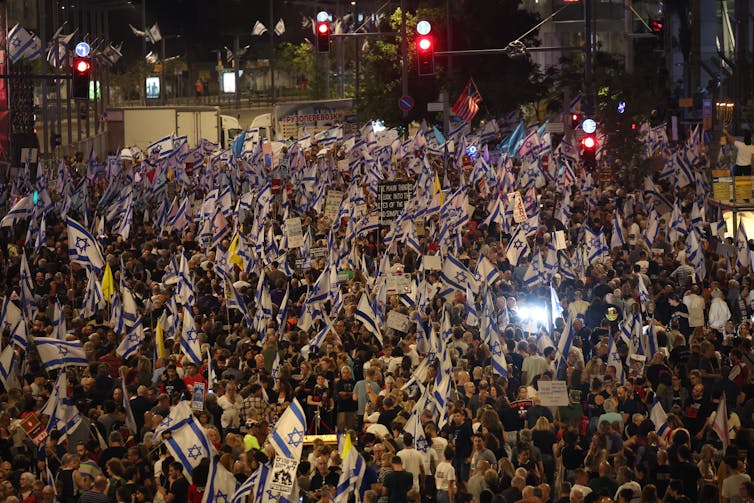In all conflicts, the period preceding a ceasefire agreement is the most dangerous, as each side tries to gain the best military position before the fighting ends. The long, drawn out negotiations aimed at bringing a halt to the war in Gaza are no exception.
Hamas has renewed missile attacks on Israel and Israeli forces have been undertaking operations in Rafah, which Israel has portrayed as the last Hamas stronghold, and in Jabalia in northern Gaza. The ceasefire talks hosted in Cairo have in turn been buffeted by events on the ground.
The way Israel and Hamas judge their progress in the war tells us a lot about the prospects for the talks.
The past week has demonstrated that the war is not going well for Israel. Four months ago, Israel announced that it had “dismantled” Hamas battalions in northern Gaza. Now, its troops are back battling Hamas once more, not only in Jabalia but in several other places near Gaza City.
This underlines Israel’s failure to achieve a “total victory” over Hamas and highlights the weakness of the intelligence on which its battle plans have been based. It is evident that Israeli intelligence underestimated the extent and sophistication of the tunnels beneath Gaza and the tactical flexibility of Hamas.
Yet the Israeli prime minister, Benjamin Netanyahu, frequently claims that Israel is on the road to victory. This colours his attitude towards the ceasefire negotiations – that there will be no permanent ceasefire, and the war on Gaza will continue.

On the other side, the war has been a propaganda triumph for Hamas. Pictures of the terrible suffering of the Palestinian people have been beamed across of the world.
Hamas also demonstrated its deft publicity skills when it announced that it had accepted a ceasefire agreement brokered by Egypt on May 6. In reality, Hamas had only accepted the framework and had made counter proposals on the critical details such as the release of Israeli hostages. Nonetheless, the message that Hamas had accepted the agreement became a news headline.
Read more: Gaza war: success of Egypt's peace deal would set blueprint for future of Middle East – expert Q&A
Despite the atrocities of October 7, Hamas delegations are welcome in Russia, Iran, Turkey and South Africa. And it appears to see the demonstrations and student protests across Europe and North America as weakening western resolve to support Israel. There is reason to believe that Hamas, rather cynically, thinks the war is going well, at least politically.
The group claims the war has brought the Palestine question to public attention around the world. Its attitude towards a ceasefire needs to be seen in this light. Hamas has made it clear that it only wants a ceasefire on its terms – one that would effectively mean it remaining in power in some form in Gaza.
A deal is still far off
Despite these factors, the negotiations continue. Assessing their progress is very difficult given the many layers of decision-making involved. The political leaderships are speaking through official teams of negotiators and the intelligence services of Qatar, Egypt, the US and Israel.
Hamas is divided between its internal leadership in Gaza and external leadership in Qatar. The group’s Qatar-based political leader, Ismael Haniyeh, is senior in the hierarchy, but its leader in Gaza, Yahya Sinwar, also occupies a critical position.
They are not political rivals. But whereas Sinwar is on the ground – or more likely in his tunnel – Haniyeh is more exposed to international diplomacy. It also often takes around 48 hours for messages to be passed back and forth between the two.
In Israel, there is a sharp divide between those whose priority is crushing Hamas and those who prioritise the release of the hostages. The 132 remaining hostages have spent well over 200 days in captivity and daily demonstrations aim to pressure the government to reach a deal to bring them home. It is already too late for many who have died and the fear is that many more will succumb to the terrible conditions in which they are kept.
However, far-right members of Netenyahu’s coalition have all but rejected a ceasefire, while more moderate members want one. This has led to tensions with the opposition National Union party that is part of the emergency war cabinet.

Hanging over the ceasefire negotiations is the question of what comes next for Gaza after the war. The current framework under discussion in Cairo is a 42-day ceasefire deal, with a discussion over a more permanent cessation of hostilities referred to as “sustainable calm”.
The Israeli government has no realistic plan for the “day after” other than an Israel military presence and some unspecified Palestinian civil administration. In other words, a return to the situation before the war but with an Israeli military occupation of Gaza. This is a recipe for recreating the conditions that led to the October 7 massacres. It would bring neither security to Israel nor peace for the Palestinians.
One of Israel’s former prime ministers, Ehud Olmert, has argued it is in Israel’s interests to set a new agenda for Israelis and Palestinians. For him, the Israeli hostages should be returned in exchange for an end to the war.
That should be followed with Israel withdrawing from the Gaza strip and being replaced by an international peacekeeping force that is preferably Arab-led. And in the longer-term, concrete steps must be taken towards establishing a Palestinian state.
Olmert understands that politics must determine military action. Unfortunately, the Israeli government and Hamas want military action to shape their politics. This is not to say there will not be a ceasefire in Gaza, but it does not bode well for future peace in the Middle East.

